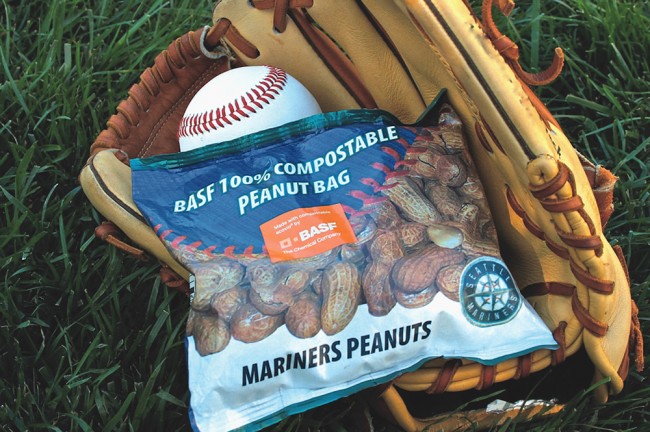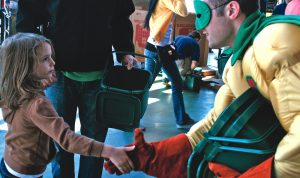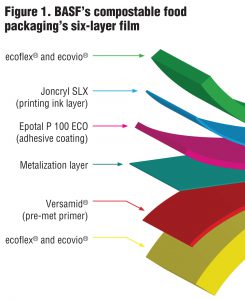Introduction of compostable snack bags at a game in September has potential to help this major league baseball team reach a goal of 90 percent diversion.
Molly Farrell Tucker and Nora Goldstein
BioCycle December 2012, Vol. 53, No. 12, p. 25

A prototype compostable snack bag of peanuts was given out to the first 10,000 fans to arrive at Safeco Field in September.
“In 2005, [the Mariners] were diverting 12 percent of the waste stream,” Scott Jenkins told BioCycle during an interview in 2010 (see “Take Me Out To Windrow,” December 2010). Jenkins, Vice President of Ballpark Operations for the Seattle Mariners, began working with the team in 2006. “I knew there were opportunities to do better than that. We did a few trash audits and quickly realized that organics was going to be a big part of it.” With capturing food waste for composting as part of the mix, the diversion rate climbed to 18 percent in 2006, 25 percent in 2007, 31 percent in 2008 and 38 percent in 2009. Jenkins has his sights set on 90 percent diversion, but closing the gap has proven to be an elusive goal. “All of our service ware is already compostable, but snack food bags have been one of the biggest barriers preventing us from getting to our goal,” he explains.
Sustainable Saturdays
There were ten Sustainable Saturday events during the Mariners’ home games in 2012. The first was held at the Earth Day weekend game on April 17, 2012, where fans received the compost kits. The liners were supplied by Ecosafe and were produced with BASF’s ecovio® biodegradable polymers. Fans also received coupons from Seattle Public Utilities for free bags of compost from Cedar Grove Composting, which processes organics and food scraps generated at Mariners’ games. BASF also introduced its Kid Compost Trivia game where fans compete to win an Amazon Kindle Fire. “We basically ask an environmentally themed question at the end of the first inning and encourage fans to visit one of our 16 Zero Waste Stations for information about our zero waste initiative, where we have Camp Fire USA volunteers working to help fans recycle and encourage them to play the game,” explains Jenkins. “At the end of the seventh inning, one lucky fan who has texted in the correct answer is awarded a Kindle Fire and an autographed baseball.”

On Sustainable Saturdays in 2012, fans received compost kits that included a kitchen countertop container. Children were greeted by “Kid Compost.”
The Mariners are founding members of the Green Sports Alliance (GSA), created in January 2010 to bring together venue operators, sports team executives and environmental scientists to exchange information about better practices and develop cost-competitive and innovative solutions to meeting their environmental and sustainability goals. The idea for Sustainable Saturdays grew out of a collaboration with the Mariners, BASF and Green Bear Group (part of GSA). The three parties came together in early January 2012 and brainstormed the idea for the fan engagement program. “Sustainable Saturdays has been a great way for us to improve the fan experience at the baseball games and have the fans take the composting concepts that they are doing at Safeco Field to their homes,” says Christopher Bradlee, BASF’s Market Development Manager for Biodegradable Polymers in North America. “It has resulted in improving awareness about the importance of organics recycling.”
Compostable Snack Bags
While the Sustainable Saturdays program, which will continue in 2013, engages the fan base, the prototype compostable peanut bag addresses one of the challenges with increasing the Mariner’s diversion rate. “Whenever there are contaminants in our compost stream, like regular snack bags and candy wrappers, we have to pay a premium to have them removed by hand,” notes Jenkins. “If all of the snacks sold at Safeco Field came in compostable packaging, it would represent a significant savings of time and money for the team and get us a whole lot closer to achieving zero waste.”
While the waste diversion program at Safeco Field has been a challenging, multiyear process, the financial savings have started to add up considerably: In 2011, the Mariners saved $95,000 in avoided landfill costs. While these savings are a direct result of the Mariner’s 81 percent landfill diversion rate, part of the savings does have to do with the local infrastructure in Seattle, Jenkins notes. “In big population areas it costs a lot to send things to a landfill. We’re lucky it costs less to compost. So there’s an economic incentive for us to divert from landfill to composting.”
Molly Farrell Tucker is a Contributing Editor to BioCycle.











